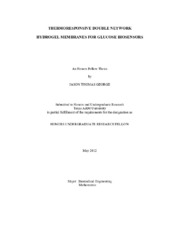| dc.description.abstract | Poly(N-isopropylacrylamide) (PNIPAAm) hydrogels reversibly switch from a water-swollen to a deswollen state when heated above their volume phase transition temperature (VPTT = ~ 33 °C). It has been shown that PNIPAAm hydrogel surfaces release adherent cells with thermal cycling. We propose the use of PNIPAAm hydrogels as membranes for implanted biosensors to actively combat biofouling through thermal modulation. To enhance the feasibility of this approach, the hydrogel membrane must be mechanically robust, exhibit rapid swelling and deswelling properties, and operate within the temperature range of interest (~37 ºC) for protein and cell removal. Toward this goal, we have prepared PNIPAAm double network (DN) hydrogels synthesized in two steps with the first network highly crosslinked and the second loosely crosslinked in order to increase the mechanical integrity of the PNIPAAm hydrogel. Colloidal poly(dimetylsiloxane) (PDMS) nanoparticles (average diameter = ~220 nm and ~50 nm) were incorporated into the first or second network to increase swelling and deswelling kinetics. N-vinyl-2-pyrrolidone (NVP), a hydrophilic comonomer was introduced to raise the VPTT above the threshold temperature. The resulting thermoresponsive nanocomposite hydrogels were characterized with respect to their morphology, mechanical properties, and swelling/deswelling behavior and release of cells upon thermal modulation. In addition, the introduction of 2-Acrylamido-2-methylpropanesulfonic acid (AMPS), a negatively charged comonomer, was explored independently in order to increase mechanical strength and improve swelling and deswelling kinetics. To utilize the hydrogel design as a functional membrane, attempts have been made to directly incorporate tetramethylrhodamine isothiocyanate concanavalin A (ConA), a glycoprotein utilized in the sensing chemistry. We investigate the delivery of ConA-loaded calcium carbonate microspheres (CaCO3) into the DN hydrogels. | en |


